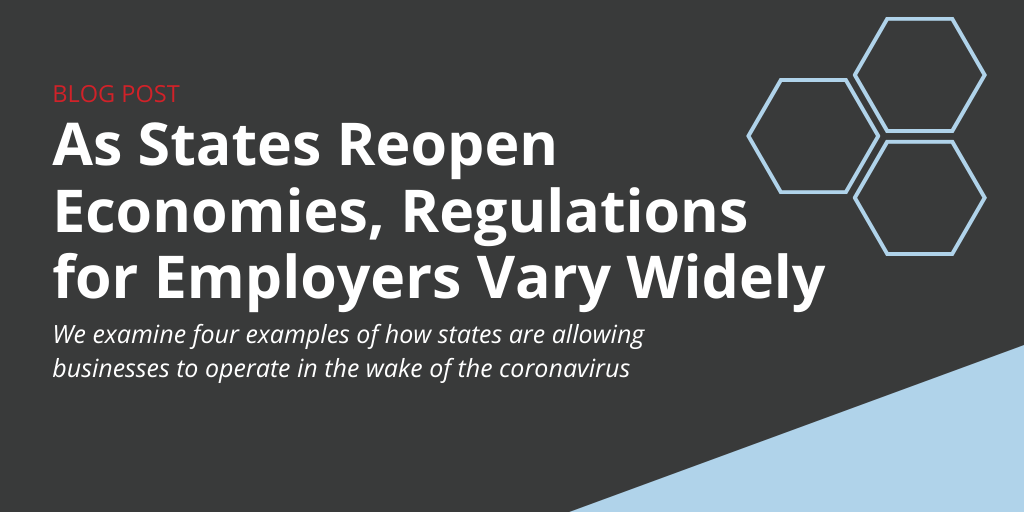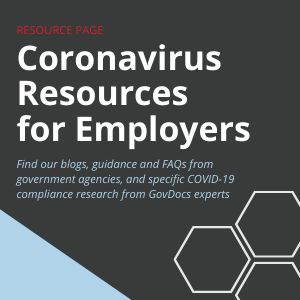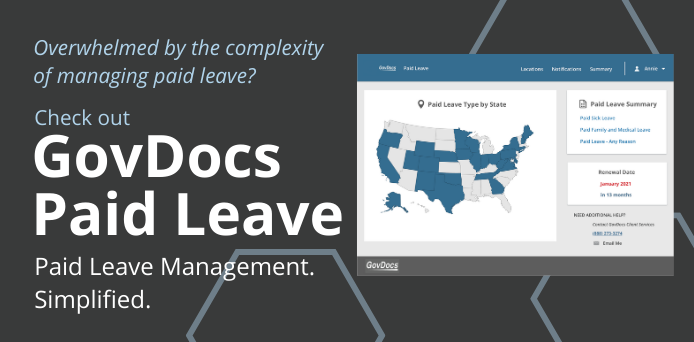EMPLOYMENT LAW NEWS
As States Reopen Economies, Regulations for Employers Vary Widely
By Kris Janisch
Published May 28, 2020

Employers with locations in multiple jurisdictions should consult local rules and orders as they prepare to reopen.
With all 50 states at least partially reopening their economies in the wake of COVID-19, the regulations vary widely, creating additional complexities for multi-jurisdiction employers.
The individual state rules and orders cover a multitude of items. These include:
- Types of businesses that can open
- Social distancing parameters
- Mask-wearing guidance
- Opening limitations by county
Below, we will examine a few states and what employers must do to remain complaint — and maintain safety for employees and customers — as the nation begins climbing out of the coronavirus-related closures.
Related: Coronavirus Update – States Start Reopening Economies
Employers with locations in several jurisdictions should be sure to consult local regulations, which are changing quickly depending on the particular state’s response to COVID-19.
New Jersey
Near the hub of coronavirus activity in the U.S., New Jersey hasn’t been as aggressive as other states in reopening its economy.
Officials there, however, believe the state has passed the peak of COVID-19 and New Jersey has reached its testing goal. In the meantime, the state since mid-May has entered Stage 1 of its “Road Back” reopening plan.
For now, Stage 1 allows for:
- Curbside retail
- Takeout and delivery at restaurants
- Drive-ins
- Non-essential construction
- Elective surgeries
- Beaches and state and county parks
Stage 2 of New Jersey’s plan to reopen its economy has yet to be announced. When enacted, it will include:
- Expanded retail
- Outdoor dining
- Indoor dining at “significantly reduced” capacity
- Museums
- Libraries
- Limited “personal care,” such as nail salons
Eventually, Stage 3 will allow most activities, including bars and some entertainment venues, but safeguards will continue to be in place.
North Carolina
In North Carolina, Phase 2 of effort to reopen the economy got underway May 22.
Gov. Roy Cooper called the measure a “modest” step forward for North Carolina, as it entails limitations on how businesses operate. Retail businesses had already been allowed to operate at 50 percent capacity during Phase 1.

Now, additional businesses can open at 50 percent capacity with cleaning and distancing requirements. Those include:
- Dine-in restaurants
- Personal care businesses (salons and barbers)
- Pools
Also, employees at personal care businesses will be required to wear face coverings. The state has provided additional training resources for employers.
What will remain closed during Phase 2 in North Carolina? Night clubs, gyms and indoor fitness facilities, bars, bowling alleys and indoor entertainment venues, i.e., movie theaters.
Phase 2 of North Carolina’s plan will run through at least June 26.
Pennsylvania
Unlike the states noted above, Pennsylvania uses a color-coded system for its reopening plan. The state classifies counties differently, making it doubly difficult for employers to track Pennsylvania’s regulations.
Starting May 29, eight counties in Pennsylvania will go to “Yellow,” while 17 will move to “Green” status. (Another handful of counties are expected to remain “Red” until June 5.) The list of the counties can be found on the governor’s website.
So, what do these colors mean?
Red, of course, means a near total lockdown except for those businesses deemed essential. Bars and restaurants have been able to offer delivery and carryout, however.
Yellow
At a high level, here’s what the Yellow status means for counties in Pennsylvania:
- In-person retail is allowed, though pick-up and delivery is preferred
- Restaurants are still limited to delivery and carryout
- Gyms, spas, salons and similar businesses remain closed
- Movie theaters and casinos remain closed
Under the Yellow designation, Employers must also inform customers of safety guidance. The state has issued flyers regarding these regulations.
Green
Green doesn’t mean full go in Pennsylvania. While more businesses in Green counties may open, they must do so at 50 percent occupancy. They include:
- Bars and restaurants
- Hair salons and barbershops
- Gyms, spas, etc.
- Malls, casinos and theaters
Construction work can return to full capacity, however.
Find additional guidance on Pennsylvania’s Red-Yellow-Green phases on the state’s website.
South Carolina
A bit ahead of the others here in terms of reopening, South Carolina on May 22 announced that attractions — such as zoos, waterparks, museums and more — can operate so long as they follow certain guidelines.
That comes on the heels of South Carolina allowing many businesses to reopen May 18. Those included:
- Gyms
- Barbershops and salons
- Tattoo shops
- Other “close-contact” businesses
Of course, South Carolina has issued guidelines on health checks for employees, social distancing, cleaning and sanitizing, and more.
Meanwhile, South Carolina has allowed other businesses to reopen under a slightly different formula:
They “must limit the number of customers allowed to enter and simultaneously occupy the premises so as not to exceed five customers per 1,000 square feet of retail space, or 20 percent of the occupancy limit as determined by the fire marshal, whichever is less. Businesses must not knowingly allow customers to congregate within six feet of one another, exclusive of family units,” according to the state’s guidance for non-essential businesses.
For restaurants in South Carolina, it’s more straightforward — they can operate at 50 percent capacity or less, with tables spaced 6-8 feet apart.
Conclusion
The economy is starting to reopen.
For employers, however, it will remain a challenge to determine what can open and when, along with additional regulations and procedures mandated by state agencies.
Along with new paid leave laws, coping with employee fears and the difficulties of managing a remote workforce, the coronavirus continues to create hurdles for employers across the U.S.
This Employment Law News blog is intended for market awareness only, it is not to be used for legal advice or counsel.
Keep Informed
with GovDocs Labor Law News

What is GovDocs?
GovDocs simplifies employment law compliance for large, multi-jurisdiction employers in the U.S. and Canada. The GovDocs software platform integrates three solutions in one convenient place to help you master the employment laws impacting your business. Whether you manage a postings, minimum wage or paid leave program, our products cut through research time, provide proactive insights into the everchanging landscape of employment laws and reduce the risk of noncompliance. The company is headquartered in St. Paul, Minn.
Have fewer than 30 locations?
The GovDocs Poster Store simplifies posting compliance for employers with less than 30 locations across all industries, offering a variety of posting products to meet your labor law compliance needs.



